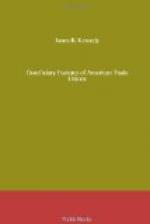[Footnote 182: Constitution, 1905 (Quincy, n.d.), p. 45.]
[Footnote 183: Constitution of the Leather Workers on Horse Goods, 1905 (Kansas City, n.d.), p. 22; Constitution of the International Tobacco Workers’ Union, 1900, third edition, 1905 (Louisville, n.d.), sec. 43.]
The cost of the exemption of dues in none of the unions is large. The following table gives the chief facts concerning the benefit in the Iron Molders’ Union for the period 1900-1906:
Out-of-work relief
in the Iron molders’ union.
==========================================================
Year. |Number of Stamps| Value of | Cost per
Member
|Issued
Yearly. |Out-of-work[184]| per Year.
|
| Stamps |
----------------------------------------------------------
1901 | 26,349 | 6,587.25
| .12
1902 | 10,389 | 2,597.25
| .04
1903 | 26,073 | 6,518.25
| .04
1904 | 92,685 | 23,171.25
| .27
1905 | 24,906 | 6,226.50
| .07
1906 | 16,676 | 4,169.00
| .04
----------------------------------------------------------
Average| 31,502 | $7,875.50 | $0.10
----------------------------------------------------------
i>
[Footnote 184: Approximate number only. Data furnished by Mr. R.H. Metcalf, financier of the union.]
The great variations in the number of out-of-work stamps issued is due, of course, to variations in the amount of unemployment. The annual amount of unemployment per capita, so far as it is measured by the number of stamps issued, varied from less than one fourth of a week in 1902, 1903 and 1906 to one and one half weeks in 1904. The per capita cost of maintaining the benefit varied from four cents in 1902, 1903 and 1906 to twenty-seven cents in 1904.
In the history of certain of the principal unions a system of loans or travelling benefits has preceded the out-of-work benefit. The travelling benefit may indeed be termed the first stage of out-of-work relief. The following unions maintain the travelling benefit either in the form of a loan or of a gift: the Cement Workers, Chain Makers, Cigar Makers, Compressed Air Workers, Deutsch-Amerikanischen Typographia, Flour and Cereal Mill Employees, Fur Workers, Glass Snappers, Hod Carriers, Lace Curtain Operatives, Leather Workers on Horse Goods, Machine Printers and Color Mixers, the Mattress and Spring Bed Workers, Shipwrights, Slate Quarrymen, Tile Layers and Helpers, and the Watch Case Engravers. The travelling benefit and the out-of-work benefit are complementary in several of these unions. The systems of travelling benefits maintained by the Cigar Makers, the Leather Workers on Horse Goods and the Typographia are the most important.




